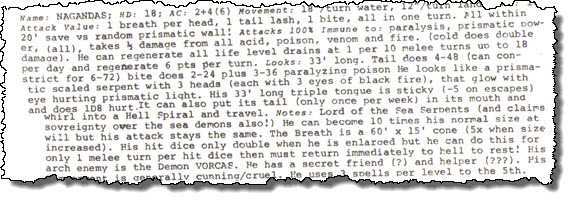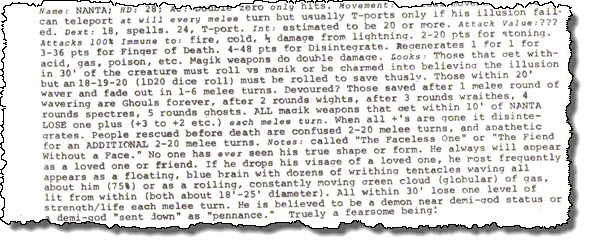The Runes Of Doom, Part XII
Demons & Demons
& Demons
& More Demons
How People Ever Got The Idea Roleplaying Was Satanic, I Dunno
Of course, the only people who could believe RPGs were full of authentic demonology (which is kind of like “working homeopathy”) are people who knew absolutely nothing about either RPGs or demonology, and, yup, those are the kind of people who did. The fact is, no medieval Catholic monk, no matter how crazed they might have been after several decades of being monastic, could have, or did, come up with anything as awesome as Dave Hargrave’s creations.
I mean, there’s…
Dagonus: Three-headed (each head has three eyes) dragon with scales of silver and gold, ninety foot wingspan. (Yeah, fit that on your battlemat…) Takes half damage from stoning, which means, uhm, I dunno. Turned half to stone? “Death” magic just rebounds on the caster. Breathes fire or lightning as frequently as every other melee round, three times a day for fire, four for lightning. And he likes to get free-kay with Tiamat… or “the queen of evil dragons”, because no demon is scarier than TSR’s lawyers. (There’s a reason people used to joke TSR stood for “They Sue Regularly”. They did not, however, try to trademark “Nazi”. That one’s an urban legend.)
Gorok: A cross between a lobster and tyrannosaurus. With nine eyes. And it has extra mouths in its pincers so that when you’re grabbed, you’re also eaten. Holy fracking hell. I thought some of the things that crawl out of my imagination and into Excel sheets to be statted out were weird, but I don’t even come close to Dave Hargrave. He is the Amber of high gonzo; everything else is just a distorted shadow.
Groak: Not to be confused with Gorak, above. Groak is a giant frog with a head like a sea anemone. He is the “Lord of Swamps”. His mere touch causes all those below 5HD to go insane with pain, and also goes 6-36 acid damage, which mean the insanity doesn’t last long, as how many people level 4 and below can survive 6d6 damage?
Karong: Winning the award for “demon whose name most resembles a Don Martin sound effect”, he has three eyes, each of which does something different. The red eye burns you, the yellow eye “rots” you, and the green eye turns you into green slime. He is the “Lord of Slimes”, and also of traffic lights. (I may have made that part up…) He can telekinetically “throw” one of his “pets” (any of a number of slimes) up to 60′. Oh, and lastly, he has a “vampire like” charm, so perhaps he’ll be the love interest in a YA novel soon.
Kavring: Speaking of “vampire like charm”, this 10′ tall winged humanoid made of solid ruby also has it. Fitting the “ruby” theme, he has a plethora of fire powers, including a burning aura, flames shooting from his fingertips, polymorphing into a pheonix, etc. His favorite food is hobbit meat, and have I mentioned that I love these odd little asides? I want to know what his favorite classical composer is, too, and if he was a polearm, what kind of polearm would he be? (Myself? Glaive-guisarme, of course. What other possibility is there?)
Moloch: An actual demon, more or less. (I’m aware many of the others have names drawn from mythology; I’m too damn lazy to bother looking up which ones, precisely, and how much they differ from their source media.) He is a fire demon “13 1/2 feet tall”. Exactly 13 feet, 6 inches? Or is he really only 13 feet, 5 3/4 inches? These things matter! Continuing the theme of demonic rivalry (which is only sensible, really), he is the arch enemy of ABADDON. (Hey, it’s ALL CAPS in the text, who am I to argue?) His favorite foods? Roast unicorn and virgin elf maiden. (No one in fantasy worlds ever seems to want virgin men, for some reason. (Well, in the real world, too. Has any woman ever said “You know what really turns me on? Guys who have absolutely no idea what they’re doing in the sack.”?)) He can also burn/melt a path through solid rock at 5’/minute, so, if you’re dumb enough to summon him, do it on the lowest floor of your wizard’s tower, not the top, or you’ll have a big hole going all the way to the basement in short order.
Nagandas: Winner of the “Demon whose name sounds the most like a slang term for testicles”, as in, “Damn, that soccer ball hit me right in the nagandas!”. Also, something really wonky happens with the layout here:

With A 33 Foot Long Sticky Triple Tongue, If The Demon Thing Doesn’t Work Out, He’s Got A Career In Anime.
I cannot tell if the idea of a demon sticking its tail in its mouth and whirling into a hell spiral is awesome or ridiculous.
Nanta: Voted most like to be confused with a fruit drink completely and totally massacre you. I normally try to avoid just posting big block scans, esp. one after the other, but there’s no way to just summarize this bastard.
Let’s just look at some of the highlights, here… and I don’t mean the kind with Goofus and Gallant.
- He is only hit on “double zero”. So to attack him, you just roll percentile dice? With no modifiers? A peasant and a 50th level Paladin both have the same odds? Not sure.
- Most forms of damage actually heal him.
- Magik (sic) weapons do double damage, which is great, but they lose one “plus” per round and then disintegrate.
- But to get close enough to hit him with a magic weapon, you will “fade out”. There’s no save or HD limit; you just vanish unless “rescued”, and then you’re undead. It seems to me this is exploitable if you want to become a spectre.
- Attack Value:”???”. Really? “???”? Two decades before Everquest and three decades before WoW, Dave Hargrave pioneered the “this creature is so far out of your league you can’t even measure how far out of your league it is” metric.
- No mention of specific casting ability, but I guess that’s covered by “???”.
- Nothing about his favorite food or his “pets” or what he claims to be “lord of”. I guess he’s just too awesome to have such petty concerns.
Phroalgoea: A much more normal creature, just a 10′ tall silver-scaled winged humanoid, who can shoot deadly spines which are covered with a poison that turns orcs and elves to silver. Because, poisons turning you to silver are totally a thing. He is the lord of golems, which isn’t a typical thing for a demon to be lord of, what with the whole “golems are mindless servitors who don’t really worship anything or make bargains”, but, you know, why the frak not? Maybe he taught mankind the art of golem-making for his own purposes. He enjoys dwarf or gnome meat, animates statues, and controls non magical weapons “if allowed to concentrate”. Good luck arguing with the DM over precisely what “distracts” a demon.
Ralkul: Pals around with 6-48 mummies, 40% of which will be fireproof… sorry, all you people who learned fire kills mummies. (This was very typical of the time… monster has weakness X. Players learn it. DM introduces some version of the monster lacking this weakness. It’s kind of like how antibiotic-resistant bacteria evolve.) Anyway, Ralkul is warped and knobby old dude with one eye, elephant ears, and four arms. (He can also appear as a woman, a skeleton, or as a giant flaming skull with wings.) He is the demon king of age and corruption, and his odor is so vile that creatures of 1+1 Hit Dice (and if you think that’s “2 hit dice”, boy, have you not been paying attention…) die instantly, while others suffer various ill effects depending on their general level. He loves “rotted and putrid meat”, but isn’t picky about what species it was from.
Shabbaleth: We have a “dragon” theme going here. Also an “elf” theme. And a “gold” theme. Putting that all together, you have a giant golden “being” with a dragon’s head, four purple eyes, wings, and a tail, who sometimes appears as an elf in golden armor. He is the lord of “reptiles” but not wyverns, dragons, etc., never mind the fact he can breathe dragon fire ten times a day. In fact, he is the enemy of all dragons. He also has the by-now-expected “vampire-like charm”. He and URANDOS (to be covered in the next article) are pals, which is a nice change to the boilerplate “and his arch-foe is THISGUY” in many of the others.


Double zero = 20. Back in the 70’s there weren’t many d20’s so two d10’s has to suffice when you were rolling your attacks.
I started playing in 1978. There were plenty of D20s, often marked 0-9 twice, so you had to color them in. D10s, being non-Platonic, were relatively new,
created for gaming only(See Below). We used to roll 2 D20s, of different colors, for percentiles, leading to endless arguments over which color you declared was “high” right after you rolled and saw the result. When more and more D20s were number 1-20, they became less useful as ersatz percentiles, and this led to the explosion of actual 10-sided dice on the marketplace (though it took a while before I started seeing them sold with one die labeled in actual 10s (10, 20, 30…00) and one in single digies. Of course, when Vampire came out in the early 90s, that was when you began to drown in D10s.Evidently, the ten sided die was patented way back in 1909. But it wasn’t part of the classic D&D dice. (It’s a common myth that the first D&D sets had chits, not dice. One of the editions of the basic set had chits, true, but it was after the explosion of D&D popularity caused a shortage of the original “low impact” dice TSR had been using. Older sets did include dice… a white D20 (later accompanied by a pink D20, but not in the first edition of Holmes Basic), a red D6, a yellow caltrop… I mean, D4, a green D8, and a blue D12.
The overlap between the names appearing in Hargrave’s books, and the name of the Chaosium founders, who worked with percentile systems, is very high, and I suspect some D100 mechanics drifted into Dave’s games in various ways.
You’re correct. I meant to say they were double sided d20’s( been a very, long time since I’ve seen one), but the original Arduin combat system was based entirely on OD&D’s descending rules mechanics with a little twist on the number ratings. So, an armor class of 2+7 ( equivalent to -9) was the highest AC you could have.
Before actual d20s that were numbered 1-20 rather than 0-9 twice, we rolled for attacks using a d6 and d20, where the d6 determined whether the d20 result was 1-10 (0 being 10) or 11-20 (0 being 20). A 4-6 roll on the d6 added +10 to the d20 roll. Then we realized we could color the sides or use a crayon..